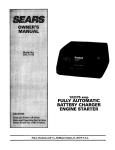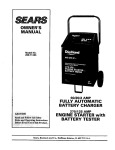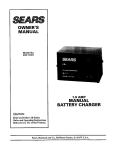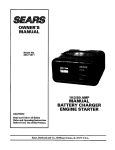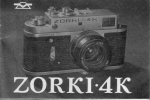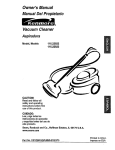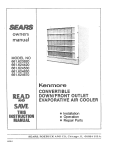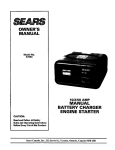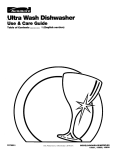Download DieHard 200.71315 Owner`s manual
Transcript
Die Hard OWNER'S MANUAL Model No. 200.71315 15/2/125 AMP FULLY AUTOMATIC BATTERY ENGINE CHARGER STARTER CAUTION: Read and Follow AH Safety Rules and Operating Instructions Before Every Use ofthis Product. Sears, Roebuck and Co., Hoffman Estates, IL 60179 U.S.A. Table Of Contents Warranty .................................................................. 1 Using Your Battery Charger .................................... 5 Important Safety Instructions .................................. Parts ......................................................................... 2 3 Setting the controls ................................................ 5 Charging your battery ............................................ 7 Before Using Your Battery Charger ........................ 4 Calculating charge time ......................................... Plugging it in .......................................................... 4 Using the engine start feature ............................. Using an extension cord ........................................ 4 Maintenance and care ......................................... Preparing your battery to be charged .................... 4 Troubleshooting ..................................................... Please read this Owner's Manual before using your Battery Charger The Sears model 200.71315, Fully Automatic Battery Charger/Engine Starter, offers a wide range of features to accommodate the needs for home or light commercial use. This manual will show you how to use your charger safely and effectively. Please read and follow these instructions and precautions carefully. Warranty FULL THREE-YEAR WARRANTY If, within three years from the date of purchase this battery charger fails due to a defect in materials or workmanship, simply RETURN IT TO THE NEAREST SEARS STORE IN THE UNITED STATES, and Sears will repair or replace it, free of charge. This warranty gives you specific legal rights, and you may also have other rights which vary from state to state. Seam, Roebuck and Co., Dept 817WA, Hoffman Estates, IL 60179 9 10 10 11 Important Safety Instructions - SAVE THESE INSTRUCTIONS • Read all instructions and cautions printed on the battery charger, battery, and vehicle or equipment using battery. • Use charger only on lead-acid type rechargeable batteries, such as those used in cars, trucks, tractors, airplanes, vans, RV's, trolling motors, etc. This charger is not intended to supply power to a low voltage electrical system other than in an automotive application. - • Do not disassemble charger. Take it to a qualified service professional if service or repair is required. Incorrect assembly may result in fire or electrical shock. •To reduce risk of electrical shock, unplug the charger from the outlet before attempting any maintenance or cleaning. •Always charge battery in a well ventilated area. • Use only attachments recommended or sold by manufacturer. The use of attachments not recommended by the manufacturer may result in fire, electric shock, or injury. Help us help you Remember: • Place charger as far away from battery being charged as the charger cables will permit. • Do not expose charger to rain or snow. • Never charge a frozen battery. If battery fluid (electrolyte) becomes frozen, bring battery into a warm area to thaw before you begin charging. • Never allow battery acid to drip on charger when reading specific gravity or filling battery. • Never set a battery on top of the charger. • Never place charger directly above battery being charged. The gases from the battery will corrode and damage the charger. • Never use charger for charging dry-cell batteries that are commonly used with home appliances. These batteries may burst and cause personal injury. Personal Safety • Never touch the battery clamps together when the charger is energized. • Never operate charger if it has received a hard blow, been dropped, or otherwise damaged. Take it to a qualified professional for inspection and repair. • Be sure to position the charger power cord to prevent it from being stepped on, tripped over, or damaged. • Never pull out the plug by the cord when unplugging the charger. Pulling on the cord may cause damage to the cord or the plug. • Do not operate the charger if it has a damaged power cord or plug. Have the cord replaced. Precautions For your own personal safety, please follow the following precautions: • Wear complete eye and clothing protection when working with lead-acid batteries. • Be sure that someone is within range of your voice to come to your aid if needed while you work with or are near a lead-acid battery. • Have plenty of fresh water and soap nearby for use in case battery acid contacts your eyes, skin, or clothing. If this happens, wash immediately with soap and water. Then get medical attention. • Avoid touching your eyes while working with a battery. Acid particles (corrosion) may get into your eyes. If this occurs, flush eyes immediately with running cold water for at least 10 minutes. Then immediately get medical attention. • Remove all personal metal items from your body, such as rings, bracelets, necklaces, and watches while working with a lead-acid battery. A battery can produce a short circuit current high enough to weld a ring (or the like) to metal, causing a severe burn. • Take care not to drop any metal tool or metal object onto the battery. This may spark or short circuit the battery or another electrical device that may cause an explosion. • Always operate your battery charger in an open, well ventilated area. • Never smoke or allow a spark or flame in the vicinity of the battery or engine. Batteries generate explosive gases. • Neutralize any acid spills thoroughly with baking soda before attempting to clean up. Parts This section shows an illustration of your battery charger. Use it to become familiar with where all the parts are located, and what they look like. Item 1 DescrlpUon CaseCover Pert Number 3799001420 2 3 4 Heatsink assembly CaseBottom ACUnecord 5 Transformer 7 Output Cordset Black Output CordRed 3899000398 3899000394 8 9 Circuit Breaker (2req) Meter 3999000086 5399100094 10 11 Switch(Left) Swtich(Center) 0499000000 0499000062 12 13 14 Switch(Right) Faceplate HandJe 0499060061 0899000536 3599000270 15 16 SCRModule Owner's Maneal 2299000852 0000000514 Wiring f diagram 2299000851S 3799001410 90026086 93026405 9 12 Before Using Your Battery Charger It is important to understand your charger's requirements. This section will tell you about your charger's electrical requirements and how to prepare a battery for charging. Plugging it in Your charger requires a 120V receptacle installed according to all local codes and ordinances. Using an extension cord The use of an extension cord is not recommended. If you must use an extension cord, please make sure that you follow these guidelines: • Make sure that the pins on charger's power cord fit firmly into the extension cord, and that the extension cord fits firmly into the receptacle. • Check that the extension cord is properly wired and in good electrical condition. • Make sure that the wire size is large enough for its length and for the AC ampere rating as specified in the accompanying chart. Length of Cord, in Feet 25 50 100 150 AWG* Size of Cord 18 18 16 14 *AWG =American Preparing your battery to be charged It is important that you read and follow these guidelines while you are preparing to charge your battery. Make sure that you have a 12 volt or 6 volt lead-acid battery. Set the selector switch to match the voltage rating of the battery to be charged. Clean the battery terminals. Be careful to keep corrosion from getting in or around your eyes. If you have a battery with removable cell caps, if required, add distilled water to each cell until the battery acid reaches the level recommended by the manufacturer. This will help purge excessive gases from the cells. Be careful not to overfill. If you have a sealed battery without cell caps, no action is necessary. Continue to the next step listed below. • Wire Gauge Take time to read all battery manufacturer's specific precautions, such as removing or not removing cell caps while charging, and recommended rates of charge. Wear safety glasses. See additional "Personal Safety Precautions" on page 2. Be sure that the area around the battery is well ventilated while it is being charged. If ventilation is poor, gas can be manually blown away by using a piece of cardboard or other non-metallic material as a fan. If it is necessary to remove the battery from the vehicle to charge it, always remove the grounded terminal from the battery first. A spark may be caused ff all accessories in the vehicle are not completely turned off. NOTE: A marine battery installed in a boat must be removed and charged on shore. Using Your Battery Charger For best results from your battery charger, learn to use it properly. This section will tell you how to set the controls, how to charge a battery in or out of a vehicle, and how to use the ENGINE START features. Setting the Controls All controls are located on the front of the charger. Follow these instructions to obtain the correct charge level for your battery. SELECTOR SWITCHES: Your charger has three switches: • Use the left switch to match the battery voltage-either 6 or 12 volt. • Use the center switch to select a charge type_ MANUAL, AUTOMATIC DEEP CYCLE or AUTOMATIC REGULAR. • Use the right switch to select a charge rate_2 AMP charge, 15 AMP charge, or 125 AMP ENGINE START feature. Battery Voltage: Select the voltage of your battery. The most common applications will be 12 volt. Charge Type: • Use the MANUAL setting only if you check the charging progress frequently. The charger will not stop charging when the battery reaches full charge, possibly damaging the battery if left on too long. You must monitor and unplug the charger when battery is fully charged. • Use the AUTOMATIC DEEP-CYCLE setting for all deep-cycle battery charging. The charger will automatically stop charging when the battery reaches full charge. • Use the AUTOMATIC REGULAR setting for all but deep-cycle batteries and for a sevedy discharged battery. The charger will automatically stop charging when the battery reaches full charge. • A severely discharged battery may not have enough charge to start the control circuit in an AUTOMATIC setting. In this case, charge on MANUAL until the battery has enough charge to accept an AUTOMATIC setting. 6 VOLT 12 VOLT II II MANUAL Charge Rate: ° Use the 2 AMP charge rate setting for charging small batteries and warming large batteries.The lower the charge rate, the longer it will take to charge the battery. • Use the 15 AMP rate setting for automotive, deep cycle and other large batteries. • Use the 125 AMP ENGINE START setting only to assist in cranking the engine. AUTOMATIC DEEP CYCLE AUTOMATIC REGULAR II 2 AMP 5 15 AMP ENGINE START AMMETER: Theammeter indicates the measured amount of amperes being drawn by the battery. When you first start charging a battery, the reading will be high, with the needle near 15 using the 15 amp charging rate. In the MANUAL setting, as the battery charges, the needle will fall to about 7 or 8 amps, indicating a charged battery. In either AUTOMATIC setting, the needle will fall to zero and the charger will shut off when the charger's control circuit senses a full charge. A freshly charged battery's voltage will drop shortly after charging, and the charger, if left connected, may resume charging. This off-and-on cycling will continue until the battery's voltage no longer drops enough to restart the charger. • At the 2 amp charging rate you will notice very little needle movement. DC AMPS 0 • 5 • • FULL CHARGE 10 • 15 • CHECK • BATI'ERY When cranking the engine while using the ENGINE START feature, the needle will swing into the Start (red) area of the scale. LED INDICATORS: Two LED INDICATORS provide information on the state of charge by glowing steadily or blinking at different intervals. GREEN, FAST BLINK: When the charger is charging a battery, the green LED INDICATOR will blink rapidly approximately 4 times per second. GREEN, STEADY: In AUTOMATIC, the green LED INDICATOR will glow and the meter needle will be at zero, when the charger has completed the charging cycle. In MANUAL mode, YOU MUST monitor the charging and stop the charging when the meter indicates about half the selected rate, 2 or 15 amps. The charger has a safety timer designed into the control, stopping the charge upon reaching a maximum permitted time. See chart to right. GREEN, SLOW Rate,._,_ :,_M_mdm:Tlme, 2A 20 HRS. 15A 16 HRS. RED, SLOW BLINK: If, after a pre-set number of hours, the charger fails to fully charge a battery, it will give up and the red LED INDICATOR will blink slowly to tell you that something is wrong with the battery, approximately 2 times per second. BLINK: The charger will be in the MAINTAIN mode when the slow blinking green LED INDICATOR is operating. This occurs only in the AUTOMATIC charging positions after the end of the AUTOMATIC charging cycle, approximately 2 times per second. RED, FAST BLINK: A rapid blinking red LED INDICATOR informs you that the charger cannot operate with your control setting. For example the controls are set on 12V. AUTOMATIC REGULAR, and ENGINE START. The ENGINE START feature will operate only in the MANUAL mode--the red LED INDICATOR will blink rapidly, approximately 4 times per second. RED, STEADY: When the red LED INDICATOR glows steadily, it means that the charger has not sensed a battery. The leads may be reversed on the battery posts or one or both connections may not be making a solid contact. Check your connections. 6 Charging Charging Your a battery Battery in the vehicle: 1. Arrange the power cord and charging leads carefully to avoid damage that could be caused by the hood, door, or moving engine parts. 2. Keep clear of fan blades, belts, pulleys, and other parts that can cause injury. 3. Check the polarity of the battery posts as indicated on the battery case: POSITIVE (POS, P, or +) and NEGATIVE (NEG. N or -). NOTE: The positive post on top-post batteries is usually larger than the negative post. 4. Identify which battery post is ground or connected to the chassis. THE NEGATIVE POST IS NORMALLY THE ONE THAT IS GROUNDED. 5. To charge a negative grounded post system: Connect the red (POSITIVE) battery charger clamp to the ungrounded POSITIVE (POS, P, +) post of the battery. Then connect the black (NEGATIVE) clamp to a heavy, unpainted metal part of the chassis or engine block, away from the battery. Do not connect clamp to carburetor, fuel lines, or sheet metal parts. 6. Connect the clamp to the battery post and twist or rock back and forth to make a solid connection. This will help keep the clamps from slipping off the posts and causing sparks. 7. For automatic charging, select AUTOMATIC DEEP CYCLE or AUTOMATIC REGULAR as a charge type then select a charge rate. The charger will stop charging when the battery is fully charged. 8. For manual charging, select MANUAL as a charge type then select a charge rate. The charger will not stop charging when the battery is fully charged--you must monitor and unplug charger when battery is fully charged. Avoid overcharging, monitor the AMMETER frequently when in the MANUAL mode. 9. Next plug the power cord into an AC outlet. 10. When the battery is fully charged, in the MANUAL mode, the AMMETER pointer will fall to about half the charge rate selected. For specific positions, refer to the "Ammeter" section in "Using your battery charger" on a page 6. 11. When the battery is fully charged, unplug the charger power cord before attempting to disconnect charger clamps. 12. Standing away from the battery, remove the charger clamps In this order: (1) from the chassis connection and, (2) from the battery post or terminal. 13. Clean and store the battery charger in a dry location. 7 \ NEGATIVE GROUNDED SYSTEM Charging t. 2. 3. 4. 5. 6. 7. 8. 9. 10. 11. 12. your battery outside the vehicle: Remove the battery from vehicle, making sure to disconnect grounded terminal first with all accessories and lights turned off in the vehicle. Check the polarity of the battery posts as indicated on the battery case: POSITIVE (POS, P, +) and NEGATIVE (NEG, N, -). NOTE: On top-post batteries, the positive battery terminal usually has a larger diameter post than the negative one. Connect the red (POSITIVE) charger clamp to the POSITIVE post of the battery. Be sure to rock the clip back and forth to make a solid connection. Attach a 6-gauge (AWG) or a 4-gauge (SAE) insulated battery cable of at least 24-inches in length to the NEGATIVE battery post. This cable will provide a safer connection because arcing and sparking will occur away from the battery. (The battery cable is not provided with the charger, but may be purchased at most automotive accessory outlets.) Take the other end of the 6-gauge (AWG) or a 4-gauge (SAE) insulated 24-inch cable and, standing as far away from the battery as possible, connect the black (NEGATIVE) lead of the charger to the free end of the cable. Rock the clamp to make a solid connection. IMPORTANT: Wear safety glasses and face away from the battery while making this final connection. For automatic charging, select AUTOMATIC REGULAR or AUTOMATIC DEEP CYCLE depending on the type of battery, then select a charge rate. The charger will quit when the battery is fully charged and will restart if the battery voltage drops too low. For manual charging, select MANUAL as a charge type then select a charge rate. The charger will not stop charging when the battery is fully charged -you must monitor and unplug charger when battery is fully charged. Avoid overcharging, monitor the AMMETER frequently when in the Manual mode. Next plug the power cord into an AC outlet. When the battery is fully charged in the MANUAL mode, the AMMETER pointer wUlfall to about half the charge rate selected. For specific positions, refer to the "Ammeter" section in "Using your battery charger" on page 6. When the battery is fully charged, unplug the charger power cord before attempting to disconnect charger clamps. Stand away from the battery and remove remove the charger leads from the NEGATIVE connections first, then from the battery post or terminal. Clean and store the charger in a dry location. POSITWE NEGA_VE BATTERYCHARGER BATTERY 24",6 GAUGE CABLE CORD TO POWER OUTLET Calculating The Chart charge time Method Use the following chart to estimate charge time when charging in the MANUAL Mode. First, identity where your battery fits into the chart. • Small batteries -- motorcycles, garden tractors, etc. -- are usually rated in Ampere Hours (AH). For example; 6 to 12, or 12 to 32 AH etc. Batteries in cars and smaller trucks are usually rated in Reserve Capacity (RC), Cold-Cranking Amps (CCA), or both. SMALL BATI'ERIES CAR/TRUCKS • Marine, or deep-cycle batteries are usually rated in Reserve Capacity (RC). • NR means that the charger setting is NOT RECOMMENED. Find your battery's rating on the chart to the right and note the charge time given for each charger setting. The times given are for batteries with a 50-percent charge prior to recharging. Add more time for severely discharged batteries. Motorcycle, garden tractor, etc. 6-12AH 2-4 NR 12 -32 AH 4-10 NR 200 - 315 CCA 40 - 60 RC 11 -14 11/2- 2 315 - 550 CCA 60 - 85 RC 14-18 2 - 21/2 550 - 1000 CCA 85 -190 RC 18-35 21/2- 41/2 MARINE/DEEP CYCLE 80 RC 18 21/2 140 RC 27 31/2 180 RC 3O 4 180 RC 33 41/2 The Hydrometer or Electronic Method To find the time needed to fully charge your battery, determine the battery's charge level with a hydrometer or electronic Percent-of-Charge Tester. The following table below will help you convert hydrometer readings to percent of charge values. To calculate time needed for a charge: • Find the percent of charge needed. (A battery at 50 percent charge that will be charged to 100 percent needs another 50 percent (.50). • Multiply the Amp Hour rating by the charge needed (.50) and divide by the charger setting (2 or 15 amps). • Multiply the result by 1.25 and you'll have the approximate time needed, in hours, to bring the battery to full charge. Add one additional hour for a deep-cycle battery. Example: Amp Hour Rating x charge needed x 1.25 = hours Charger Setting of charge When you know the percent of charge and the Amp Hour (AH) rating of your battery, you can calculate the approximate time needed to bring your battery to a full charge. To convert Reserve Capacity to Amp Hours, divide Reserve Capacity by 2, and add 16: Amp Hours = Reserve Capacity + 16 2 100 (AH Ratinq) x .50 (charqe needed) x 1.25 = 4.163 15 (Charger Setting) hours 1_.5 15 = 3.33 x 1.25 = 4.163 You would need to charge your 100-Ampere Hour Battery for a little more than 4 hours at the 15-amp charge rate in this example. Using the engine start feature Your battery charger can be used to jump start your car if the battery is low. Follow these instructions on how to use the ENGINE START feature. 4. After the engine starts, unplug the charger power cord from the AC outlet. Then disconnect the charger from the battery. IMPORTANT: Do not try to start the engine without a battery in it. You could cause damage to the electrical system. 1. Connect the charger to the battery and vehicle as instructed in the "Charging your battery" section on page 7. 2. Set the right-hand SELECTOR SWITCH to ENGINE START. 3. Crank the engine for no more than 5 seconds. If it does not start, wait st least 4 minutes before cranking again. In extreme cold or if the battery is severely discharged, charge the battery for about 5 minutes before cranking the engine. If the engine does turn over, but never starts up, there is not a problem with the starting system, there is a problem somewhere else with the vehicle. STOP cranking the engine until the other problem has been diagnosed and corrected. I Maintenance and care A minimal amount of care can keep your battery charger working properly for years. 1. Clean the clamps each time you are finished charging. Wipe off any battery fluid that may have come in contact with the clamps to prevent corrosion. 2. Coil the input and output cords neatly when storing the charger. This will help prevent accidental damage to the cords and charger. 3. Occasional cleaning of the case of the charger with a soft cloth will keep the finish shiny and help prevent corrosion. 10 Troubleshooting Performance problems often result from little things that you can fix yourself. Please read through this char for a 3ossible solution if a problem occurs. PROBLEM No ammeter reading. Circuit breaker in charger cycles on and off with a clicking sound MANUAL mode. Ammeter reads less than selected charge rate when charging. P0SSiBLE CAUSE Clamps not making good connection. The red LED should be glowing steadily. Check for poor connection at battery. Make sure clamps and posts are clean. 2-amp charge rate. Ammeter needle will show little or no activity at the 2-amp charge rate. AC cord and/or extension cord is loose. Check power cord and extension cord for loose tilting plug. No power at receptacle. Check for open fuse or circuit breaker supplying AC outlet. ShoRed battery clamps. Circuit breaker cycles when current draw is too high. Check for shorted cables and replace if needed. Shorted battery. The red LED should be blinking slowly. Have a qualified technician test the battery. Charger leads reversed on battery. The red LED should be glowing steadily. Correct connections to battery. Extension cord too long or i Use shorter or heavier extension cord. gauge to small. Weak cell or sulfated plate. Sulfated battery will eventually take a normal charge if left connected. If the battery will not take a charge, the red LED should be blinking slowly. Have a Sears technician test the battery. Battery is only partially charged. Continue charging battery. Charger makes a loud buzz. Transformer lamination buzz. Continue charging buzz is not abnormal. ShoR star cycle when cranking engine. Drawing more than 125 amps for 5 seconds or less. Crank time varies with the amount of current drawn from the charger. If cranking draws more than 125 amps, crank time may be less than 5 seconds. Failure to wait for 4 minute (240) seconds) between cranks. Wait 4 minutes before next prank. If the above solutions do not eliminate the problem... call toll-free from anywhere in the U.S.A. 1-800-SEARS-64 (1-800-732-7764) 7 AM to 4:30 PM CST Monday through Friday 11 Notes 12 SE/AURS OWNER'S MANUAL 15/2/125 AMP FULLY AUTOMATIC BATTERY CHARGER ENGINE STARTER Model No. 200.71315 Forinformationabouttroubleshooting Calltoll-freefromanywhereintheU.S.A. 7 amto 4:30 pm CSTMondaythroughFriday 1-800-SEARS-64 (1-800-732-7764) Forthe repairor replacement partsyouneed Call7 am - 7 pro, 7 days a week 1-800-366-PART (1-800-366-7278) Forthe locationof a SearsRepair..._ ServiceCenterin yourarea Call24 hoursa day, 7 daysa week 1-800-488-1222 When requesting service or ordering parts, always provide the following information: 8EARS • Product Type • Model Number • Part Number • Part Description 0000000514-995 America's Repair Specialists














